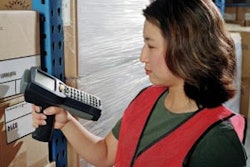Freight forwarder taps Ship2Save for radio frequency identification-enabled solution to boost productivity, provide value-add for customers
Montreal — July 29, 2005 — International freight forwarder Liaison Can/Us Courier has deployed a radio frequency identification (RFID)-enabled infrastructure across its fleet of trucks in an initiative that will allow the company to provide RFID-powered transportation services throughout North America.
Liaison Can/Us tapped solution provider Ship2Save to implement the RFID-enabled infrastructure, and Ship2Save provided both integration and consulting services to develop and deploy the solution.
Ship2Save said that the model for the system and its underlying RFID hardware network were developed to help improve internal productivity and provide an additional value tool for Liaison Can/Us customers.
"Our main goal in deploying this solution is to help our customers," said Yves D'Amours, president and CEO of Liaison Can/US Courier. "That means providing them with a way of shipping their goods through us while providing RFID repacking and tracking services, whether for compliance or efficiency."
Services like RFID repacking are useful when suppliers shipping through the transport company need to comply with various mass-merchandiser mandates but want to avoid extensive investment. The tracking services provide real-time automated data on goods during transit and at individual distribution centers and warehouses.
Daniel Rosetti, director of operations at Liaison Can/Us, knows all to well the demanding and competitive market that is transportation. "You always need to press ahead in transportation," Rosetti said. "With fluctuating currency exchanges [and] escalating fuel costs, you need to find a way of staying ahead. We looked to our customers to see what they are currently demanding, and RFID came up on top of the list. The great thing about it is, you not only can provide this amazing servicing tool for them, but internally it helps speed up loading, reduce errors and automate a great deal of activities."
Executive business analyst Konrad Konarski of Ship2Save suggest that there are "dozens of ways" that RFID can improve efficiencies within the transportation industry, citing in particular cross docking, on-the-road tracking and inventory management.
"With cross-docking, you can automatically redirect vehicles and employees to appropriate gates depending on if a specific truck is about to dock there," Konarski said. "In respect to on the road tracking, our Unit in Transit System pretty much sums things up, [providing] visibility of individual cases on a click-enabled map. And of course the obvious, inventory management: these big transportation firms need to store their customer goods somewhere also, so the typical RFID enabled warehouse is also there for transportation."
Ship2Save said it expects to deploy further such systems in the near future as the demand for RFID within the trucking industry grows.
Additional Articles of Interest
— Think your distribution operations have been put to the test? A closer look at the U.S. Army's multi-million-square-foot distribution center that was established in Kuwait two years ago to support Operation Iraqi Freedom provides some insight for companies looking improve distribution operations under harsh conditions. Read more in "Lessons from the Operation Iraqi Freedom Theater Distribution Center to Improve Your Supply Chain Operations," an SDCExec.com exclusive.
— Words of wisdom from one university professor go a long way to help business students excel in supply chain management. Read "Interview with Dr. John T. Mentzer: Teaching Supply Chain" in the June/July 2005 issue of Supply & Demand Chain Executive.
— Hard data and sophisticated planning are key when goods and materials start flowing upstream through the reverse supply chain. Read more in "Meeting the Reverse Logistics Challenge" in the June/July 2005 issue of Supply & Demand Chain Executive.
Montreal — July 29, 2005 — International freight forwarder Liaison Can/Us Courier has deployed a radio frequency identification (RFID)-enabled infrastructure across its fleet of trucks in an initiative that will allow the company to provide RFID-powered transportation services throughout North America.
Liaison Can/Us tapped solution provider Ship2Save to implement the RFID-enabled infrastructure, and Ship2Save provided both integration and consulting services to develop and deploy the solution.
Ship2Save said that the model for the system and its underlying RFID hardware network were developed to help improve internal productivity and provide an additional value tool for Liaison Can/Us customers.
"Our main goal in deploying this solution is to help our customers," said Yves D'Amours, president and CEO of Liaison Can/US Courier. "That means providing them with a way of shipping their goods through us while providing RFID repacking and tracking services, whether for compliance or efficiency."
Services like RFID repacking are useful when suppliers shipping through the transport company need to comply with various mass-merchandiser mandates but want to avoid extensive investment. The tracking services provide real-time automated data on goods during transit and at individual distribution centers and warehouses.
Daniel Rosetti, director of operations at Liaison Can/Us, knows all to well the demanding and competitive market that is transportation. "You always need to press ahead in transportation," Rosetti said. "With fluctuating currency exchanges [and] escalating fuel costs, you need to find a way of staying ahead. We looked to our customers to see what they are currently demanding, and RFID came up on top of the list. The great thing about it is, you not only can provide this amazing servicing tool for them, but internally it helps speed up loading, reduce errors and automate a great deal of activities."
Executive business analyst Konrad Konarski of Ship2Save suggest that there are "dozens of ways" that RFID can improve efficiencies within the transportation industry, citing in particular cross docking, on-the-road tracking and inventory management.
"With cross-docking, you can automatically redirect vehicles and employees to appropriate gates depending on if a specific truck is about to dock there," Konarski said. "In respect to on the road tracking, our Unit in Transit System pretty much sums things up, [providing] visibility of individual cases on a click-enabled map. And of course the obvious, inventory management: these big transportation firms need to store their customer goods somewhere also, so the typical RFID enabled warehouse is also there for transportation."
Ship2Save said it expects to deploy further such systems in the near future as the demand for RFID within the trucking industry grows.
Additional Articles of Interest
— Think your distribution operations have been put to the test? A closer look at the U.S. Army's multi-million-square-foot distribution center that was established in Kuwait two years ago to support Operation Iraqi Freedom provides some insight for companies looking improve distribution operations under harsh conditions. Read more in "Lessons from the Operation Iraqi Freedom Theater Distribution Center to Improve Your Supply Chain Operations," an SDCExec.com exclusive.
— Words of wisdom from one university professor go a long way to help business students excel in supply chain management. Read "Interview with Dr. John T. Mentzer: Teaching Supply Chain" in the June/July 2005 issue of Supply & Demand Chain Executive.
— Hard data and sophisticated planning are key when goods and materials start flowing upstream through the reverse supply chain. Read more in "Meeting the Reverse Logistics Challenge" in the June/July 2005 issue of Supply & Demand Chain Executive.
- More articles about Ship2Save.


















